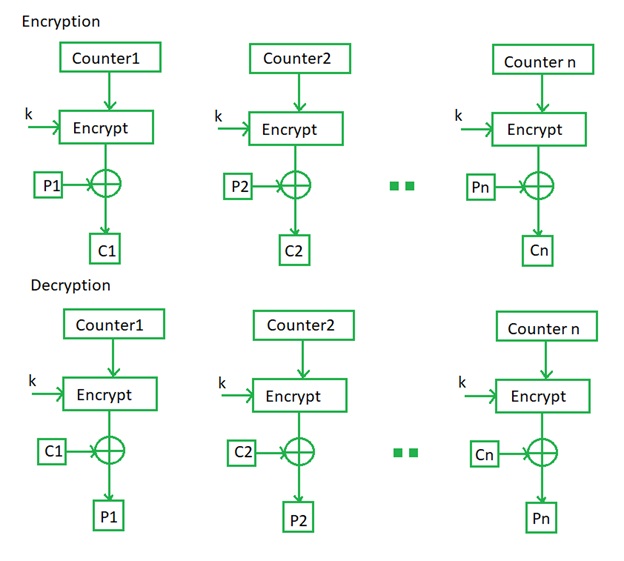Home »
Cryptography
Counter (CTR) Mode in Cryptography
Cryptography | Counter (CTR) Mode: In this tutorial, we will learn about the counter mode, its operation, analysis, advantages, and disadvantages.
By Monika Sharma Last updated : May 25, 2023
Counter (CTR) Mode
The Counter Mode or CTR is a simple counter based block cipher implementation in cryptography. Each or every time a counter initiated value is encrypted and given as input to XOR with plaintext or original text which results in ciphertext block. The CTR mode is independent of feedback use and thus can be implemented in parallel in this mode. It generates the next keystream block by encrypting successive values as named as "counter". This counter can be any purpose or function which generates a sequence that is guaranteed not to call for a long time, although an actual increment-by-one counter is the simplest or easiest and most popular or famous. When utilization of the easiest deterministic input function or work used to be promoted or secret or controversial; attacker argued that "deliberately reveal a cryptosystem to a known systematic input represents an unnecessary or unused risk."
Its simple implementation is shown below as:

Image source: https://www.geeksforgeeks.org/block-cipher-modes-of-operation/
We can be considered as a counter-based version of CFB mode without the feedback in this cryptography. In this mode, both the sender and receiver need to get access to a reliable counter, which finds out a new shared value each time a ciphertext block is exchanged or changes the value which is shared. This shared counter is not necessarily a secret value, but the challenge is that both sides must keep the counter synchronized at a time when both are active.
Counter (CTR) Mode Operation
Both encryption and decryption in CTR mode are depicted in the following illustration or steps. Steps in operation are,
- Firstly, load the initial counter value in the top register is the same for both the sender and the receiver in this mode. It plays the same role as the IV in CFB (and CBC) mode similar way.
- Then, encrypt the contents of the counter with the key and place the result in the bottom register in this mode.
- Then, take the first plaintext or original text block P1 and XOR this to the contents of the bottom register. The result of this is C1 as ciphertext. Send C1 as ciphertext to the receiver and update the counter in this mode. The counter update replaces the ciphertext feedback in CFB mode like no feedback required.
- Continue in this manner until the last plaintext block has been encrypted.
- Thus, decryption is the reverse process. This ciphertext block is XORed with the output of encrypted contents of the counter value of shared. After decryption of each ciphertext, the block counter is updated as in case of encryption in the cryptography.
Analysis of Counter Mode
- It does not have message dependency and hence a ciphertext block does not depend on the previous plaintext or original text blocks.
- Similar to CFB mode, CTR mode does not involve the decryption process of the block cipher in that way. This is because the CTR mode is using the block cipher to generate a key-stream, which is encrypted using the XOR function in cryptography. In other words, CTR mode also converts a block cipher to a stream cipher in cryptography.
Counter (CTR) Mode Advantages
- Wherever CTR mode has mostly all benefits of CFB mode. Just beside, it does not propagate the error of transmission at all in this mode.
Counter (CTR) Mode Disadvantages
- The main disadvantage of CTR mode is that it requires a synchronous counter at the sender and receiver in this mode. Decreases of synchronization lead to the incorrect recovery of plaintext or original text.
Advertisement
Advertisement